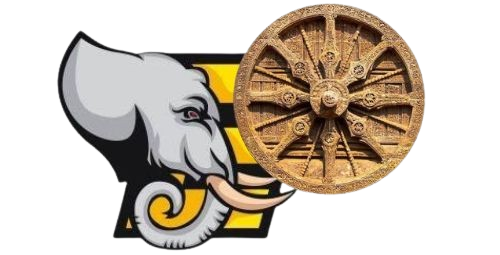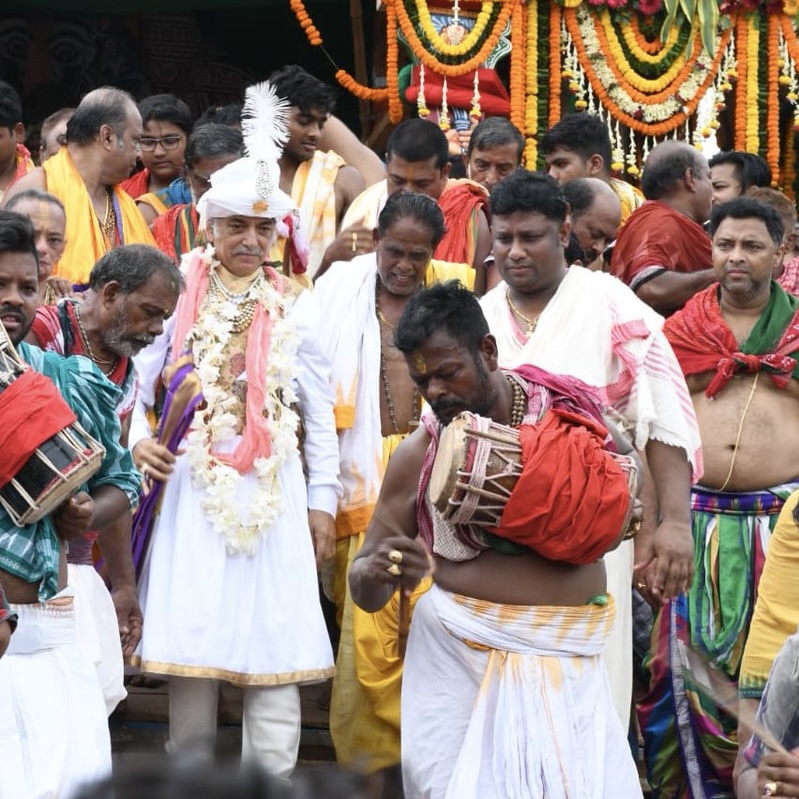Among the myriad rituals of the grand Rath Yatra of Lord Jagannath in Puri, Odisha, one particular tradition stands out for its humility, symbolism, and spiritual significance — the Chhera Pahara. Performed by none other than the Gajapati Maharaja of Puri, the ceremonial king and foremost servitor of Lord Jagannath, this ritual involves the sweeping of the chariots before they begin their divine journey.
This act of sweeping, though seemingly simple, is steeped in centuries of tradition, symbolism, and humility. It exemplifies the spirit of service in Jagannath culture, where even a king becomes a servant before the deity. This article explores the origin, meaning, and complete details behind this ancient ritual and why the Gajapati king, despite his royal stature, takes up the broom during the most important festival of Odisha.
What is Chhera Pahara?
Chhera Pahara is a ritual in which the Gajapati Maharaja of Puri sweeps the platform of each of the three chariots—Nandighosa (Jagannath), Taladhwaja (Balabhadra), and Debadalana (Subhadra)—with a golden-handled broom, accompanied by the sprinkling of fragrant water and sandalwood paste. It is performed twice during the Rath Yatra festival:
- On Rath Yatra Day – before the chariots begin their journey to the Gundicha Temple.
- On Bahuda Yatra (Return Car Festival) – when the chariots return to the Jagannath Temple.
This gesture is not symbolic alone; it is deeply spiritual, rooted in humility, and showcases the core Jagannath philosophy—“everyone is equal in the eyes of God.”
Who is the Gajapati Maharaja?
The Gajapati Maharaja is the titular king of the Puri royal dynasty and traditionally regarded as the Adya Sevaka or first servitor of Lord Jagannath. Although the monarchy no longer holds political power after the abolition of princely states in independent India, the Gajapati still plays a pivotal religious and ceremonial role in Jagannath Temple affairs.
He is not just a ceremonial figure but an integral part of the Niti (ritualistic system) of the temple. During the Rath Yatra, he symbolically renounces his royal status and performs the Chhera Pahara as an act of devotion and surrender before the Lord.
The Origin of Chhera Pahara
Mythological Roots
The practice of Chhera Pahara is believed to be rooted in ancient Jagannath tradition and finds parallels in the Bhagavata Purana, which highlights the virtue of humility even among the most powerful beings. The act reflects Lord Krishna’s teachings that service (seva) is the highest form of devotion.
Some legends narrate that King Indradyumna, who is credited with installing the wooden deities of Lord Jagannath, himself swept the temple premises as an act of purification and humility before the deity.
Historical Significance
Historically, the Gajapati kings of the Eastern Ganga dynasty and later the Bhoi dynasty (which still continues) adopted this ritual as a public demonstration of royal devotion and spiritual equality. It was institutionalized in the 15th–16th centuries, when the temple’s rituals were codified under the influence of saints and scholars like Chaitanya Mahaprabhu and Sarala Das.
This period emphasized the Bhakti movement, which preached the universal accessibility of God, irrespective of caste or status. Thus, the Chhera Pahara became both a symbolic and ritual affirmation of these ideals.
Why the Gajapati Performs Chhera Pahara
1. Symbol of Humility
The most profound reason is humility before the divine. The Gajapati, despite being the highest-ranking mortal authority in the Jagannath cult, sets aside his status, adorns a simple white dhoti, walks barefoot, and takes up the golden broom. In doing so, he embodies the spiritual principle that no one is above service to God.
2. Ritual Purification
The chariots are sanctified platforms, and before the Lord embarks on His journey, the king purifies the path by sweeping the area and sprinkling sacred water. This is not just physical cleaning but a ritual cleansing, preparing the chariot for divine movement.
3. Continuity of Tradition
By performing this duty, the Gajapati upholds an unbroken cultural and religious tradition that has endured for centuries. It connects the present with the past and assures continuity in the living culture of Jagannath worship.
4. Expression of Devotion (Bhakti)
The Gajapati’s actions reflect Nishkama Bhakti — selfless devotion. He performs his duty not for recognition or reward but out of love and reverence for Lord Jagannath, whom he considers his Rajguru (Divine Sovereign).
The Ritual Sequence of Chhera Pahara
The entire process is conducted with great precision and spiritual decorum:
- The Gajapati arrives in a royal palanquin from his palace, accompanied by a ceremonial procession.
- He ascends each chariot one by one, bowing before the deity.
- He uses a gold-handled broom to sweep the chariot platform and then sprinkles sandalwood-scented water and fragrant flowers on the surface.
- After completing the ritual on all three chariots, he descends and returns to the palace in a similarly reverent manner.
The atmosphere is filled with chants, conches, temple bells, and the rhythmic beats of mardala and ghanta, making the moment intensely devotional.
Symbolism and Spiritual Philosophy
The Chhera Pahara is more than just a ritual — it embodies the spiritual democracy of Jagannath consciousness.
Jagannath as “Patitapabana”
Lord Jagannath is known as the “Patitapabana” — the redeemer of the fallen. He accepts all—regardless of caste, creed, or class. The king’s sweeping act affirms this idea that even the highest-born must serve.
Equality and Surrender
In a world divided by hierarchy, the act of the king becoming a servant speaks volumes. It says: Before God, we are all equal, and true greatness lies in humility.
Detachment from Ego
By discarding his royal ornaments and taking up a broom, the Gajapati symbolically renounces ego, the greatest obstacle in spiritual progress.
Cultural and Social Impact
Over the centuries, this act of humility by the king has influenced art, literature, and public consciousness. Poets and writers have praised the Gajapati’s role as a servant of the Lord. In Odia folk tradition and drama, Chhera Pahara is cited as an example of ideal kingship — one that merges temporal power with spiritual responsibility.
It has also inspired social reformers to emphasize service over status, echoing the values of equality and inclusiveness that Jagannath culture represents.
Modern-Day Relevance
Even today, in the age of democracy and changing political landscapes, the Chhera Pahara ritual continues unchanged. The present-day Gajapati Maharaja, Dibyasingha Deb, performs the ritual with the same devotion and dignity as his ancestors did centuries ago.
His act reminds us that spiritual leadership transcends titles and that service remains the highest form of worship.
Conclusion
The Chhera Pahara performed by the Gajapati of Puri is a unique tradition that weaves together humility, service, history, and divinity. In this sacred act, the boundary between royalty and servitude dissolves, illustrating the core belief of Jagannath consciousness — that God is supreme, and we are all His servants.
This ritual is not just a spectacle but a profound spiritual lesson in selflessness, unity, and devotion. As the golden broom sweeps the chariot of the Lord, it also sweeps away pride, ego, and social divisions, reaffirming the enduring values that lie at the heart of Indian spiritual tradition.


